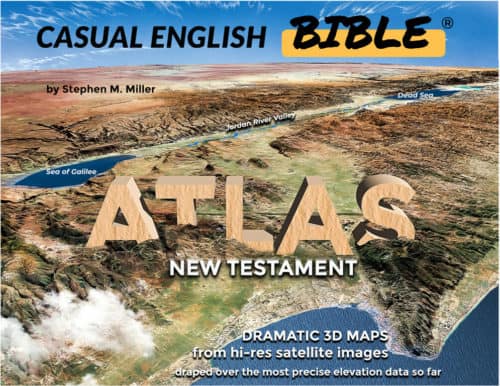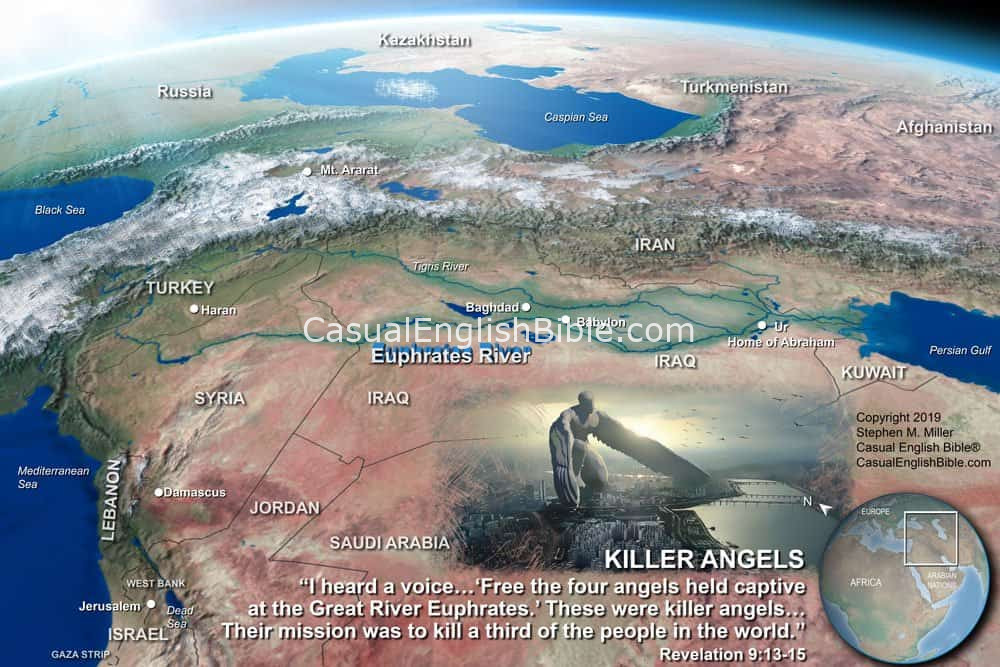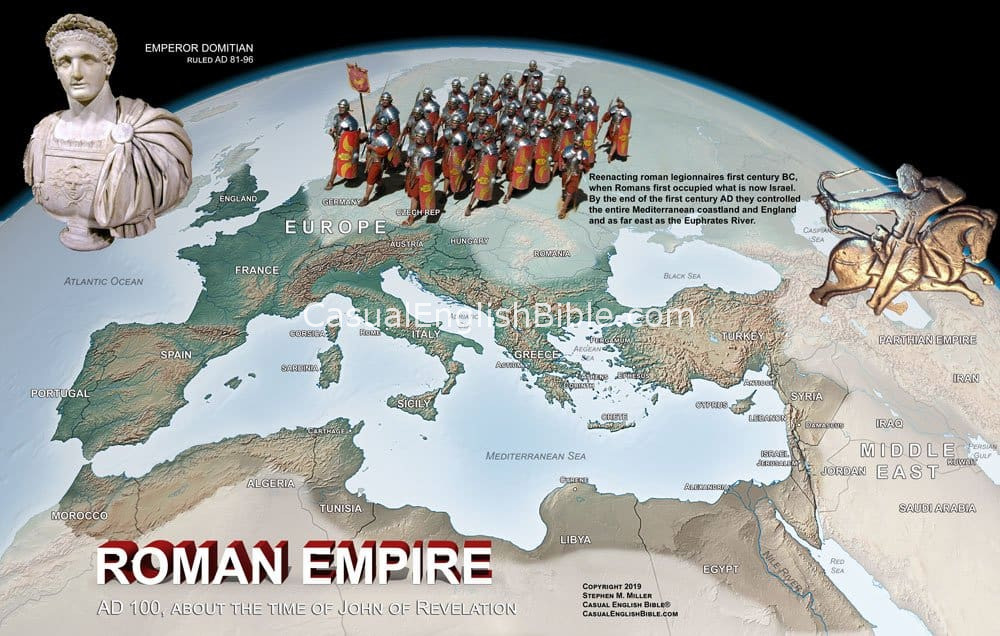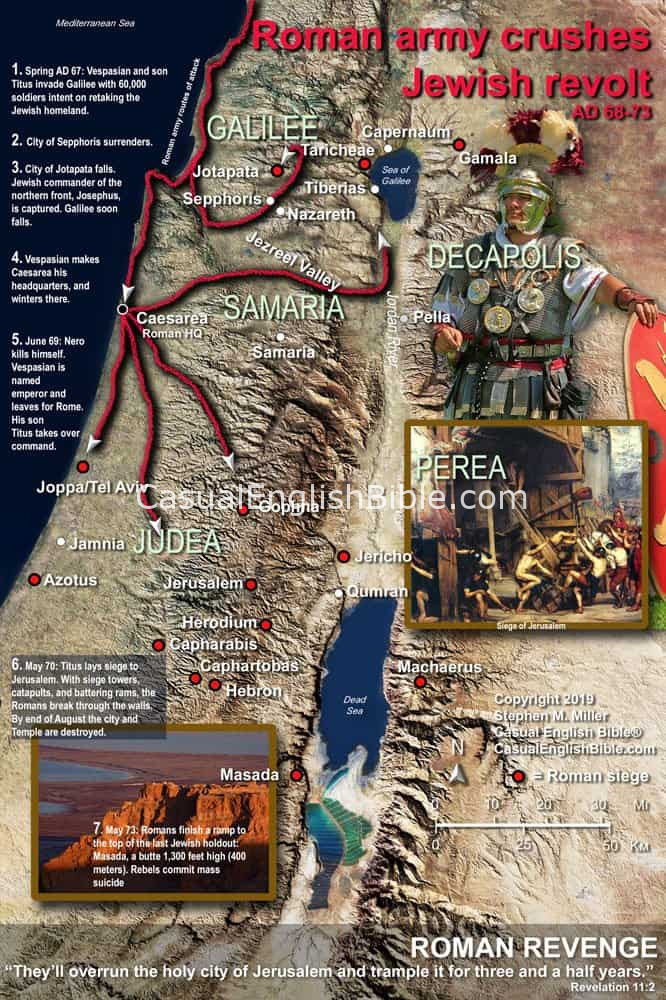Revelation 9
Trumpets of more doom
Fifth Trumpet Opens the Abyss of Punishment
1When the fifth angel blew his trumpet, I saw an angel drop out of the sky and onto the earth. [1] He had been given the key to the shaft that descended into the abyss [2] of punishment. 2He unlocked the shaft seal. Smoke belched up out of the deep hole, like the smoke of a massive furnace. Billows were so dense and dark that they saturated the air and blackened out the sun.3Locusts [3] swarmed up out of the smoke. They had the scorpion’s power to terrorize, and they used it all over the world. [4] 4Locusts got their orders not to hurt earth’s plant life—not the grass or the trees. [5] Instead, the locusts had permission to target humans. Not just any humans, but only those without God’s seal on their foreheads. [6] 5Locusts weren’t allowed to kill people. But they had permission to make life miserable for them. For five months [7] they could torture people like stinging scorpions would do.
6Times will get so tough that the people will want to kill themselves. But they won’t be able to do it. [8]
7These locusts looked like horses in battle gear. But they had human faces. And they wore gold crowns [9] on their heads. 8They had hair like a woman [10] and teeth like a lion. [11] 9They wore iron armor chest plates. And their wings roared like a battalion of war chariots charging into battle. 10They had tails like scorpions, armed with stingers. [12] Those stingers are what terrorized the people for five months. 11The king of the locusts is an angel deep in the abyss of punishment. In the Hebrew language his name is Abaddon, meaning Destroyer. [13] But in Greek, the international language, his name is Apollyon. [14] 12The first terror is over. Two more to come.
Sixth Trumpet Calls Invaders from the East
13When the sixth angel blew his trumpet, I heard a voice. It came from the four horns on the gold altar in front of God.14The voice gave these instructions to the sixth angel who just blew the trumpet, “Free the four angels held captive at the Great River Euphrates.” [15] 15These were killer angels who had been waiting for this very hour of this day in this month of this year. Their mission was to kill a third of the people in the world. [16] 16I heard someone say how many mounted soldiers were in their army: uncountable times double uncountable. [17]
17In my vision, I saw the soldiers mounted on their horses. The soldiers had armored themselves in colorful breastplates—blazing red, dark blue of a hyacinth, and sulfur yellow. Their horses had lions’ heads. Fire, smoke, and blazing sulfur shot out of their mouths. 18These three elements—fire, smoke, and sulfur [18]—poured out of the mouths of the horses. The disasters this caused killed a third of humanity. [19]
19The horses are dangerous at both ends. They can hurt people with the fire, smoke, and sulfur shooting out of their mouths. And they can hurt them with their tails, which can strike like the head of a snake. [20] 20Humans who survived these disasters didn’t learn anything from it. They didn’t change their destructive way of living. They kept on worshiping demons. And they worshiped lifeless idols made from gold and silver and bronze and stone and wood. There’s nothing to those idols. They can’t speak a word, hear a sound, or get up and take a walk. 21These people showed no remorse for what they stole, for murders they committed, for their sex sins, or for practicing sorcery and witchcraft.
Footnotes
More literally, “a star fallen from the sky.” But this star was an individual entrusted with a key to the pit. Bible writers often describe angels as stars. Job 38:7 describes angels as “morning stars.” Some scholars say the “fallen angel” is an evil angel or possibly Satan. Jesus once said, “I saw Satan when he fell out of heaven” (Luke 10:18). But some argue that it wouldn’t make much sense for God to give Satan the keys to his own prison. But many scholars say the angel is more likely an angelic messenger God sent down to earth with a job to do.
Jews at the time taught that the abyss was the underworld—the place of the dead (Romans 10:7). Luke 8:31 presents it as “home of the demons” too. Scholars sometimes translate the word abyss as “bottomless pit.” It’s Satan’s thousand-year prison in Revelation 20:1-3. It’s also linked to the depths of the sea, something Luke may have had in mind when he reported the story of demons ending up in the Sea of Galilee after Jesus cast them into a herd of pigs (Luke 8:33).
“Locusts” may be John’s colorful way of describing demons. The description is reminiscent of the eighth Egyptian plague, of locusts (Exodus 10:14). The prophet Joel compared an invading army to locusts with teeth like a lion (Joel 1:6). Some students of the Bible say the swarming locusts could describe the Roman invasion that ended with them leveling Jerusalem and the last Jewish Temple in AD 70. The locusts seem evil, yet God uses them to impose his punishment on sinful people, apparently those he held responsible for martyring some of his people (Revelation 6:9-11).
Locusts didn’t look like scorpions, many scholars say, but they had the effect of scorpions: they terrified people.
The grass was already gone, along with a third of the trees (Revelation 8:7).
“Seal on their foreheads” sounds a little like the brand or the tattoo that many in Roman times put on their slaves, marking them like livestock. Here, many scholars say it’s a metaphor that distinguishes God’s people as those under his protection. It’s a word picture intended to help people visualize an invisible spiritual reality. In this way it’s like the parables of Jesus, in which he used fictional stories to teach people what it means to live like citizens of God’s spiritual kingdom. This symbolic seal of God would be the opposite of the mark of the beast (Revelation 13:16-17).
“Five months” might refer to the dry season, when locusts chewed up the plants. Or it could refer to the lifespan of a desert locust, laid as an egg in the spring and dead by the end of summer—up to six months, depending on the availability of food. It takes longer for them to mature if there’s not much food. In this case, the “five months” would serve as a metaphor—a way to help people visualize the symbolic story and imagine the kind of real-world suffering John is describing. Five months was also about how long the Romans besieged Jerusalem before breaking through the walls and leveling the city in AD 70.
This is punishment worse than death. It’s apparently for people who martyred Christians (Revelation 6:9-11). Roman writer Seneca, in a tragedy called Troades (Trojan Women), wrote, “May you have good reason to die, but no way of dying. May you be forced to live when you want nothing more than to die” (paraphrased). That’s the kind of thing we might want to say to a serial killer or to that relative we don’t want to talk about.
“Crowns” may have been code for “powerful” or “invincible,” a bit like a large army.
“Hair like a woman” seems out of place here. Guesses about what it means: symbol of victory, the golden color of Roman helmets, or describing them as long-haired barbarians. Romans wore short hair and considered the long-haired tribal warriors from what is now Germany as barbarians.
“Teeth like a lion” was a common expression—a way of describing a powerful and often unstoppable force (Job 4:10; Joel 1:6).
If John is describing the Roman attack on Jerusalem, the stingers might refer to the catapults Romans used to throw stones and rotting corpses into the city. For those who read the future into John’s description, a modern version might be missiles. Some are even called “stingers.”
This was also one of the names for the place of the dead (Job 26:6; Psalm 88:11; Proverbs 15:11).
Apollyon also means “Destroyer.” The Greek and Roman god Apollo was the go-to god when dealing with disease and death. Emperor Domitian, reigning in the AD 90s when many scholars say John wrote Revelation, presented himself as Apollo who had come to earth in the flesh. This is one reason some scholars say John was using code words to criticize the Roman law that required people to worship the emperor.
The Euphrates River in what is now Iraq marked the eastern limit of the Roman Empire. Romans tried to venture to the other side, but armies of the Parthian Empire pushed them back in AD 62.
One theory is that these are very real demonic spirits—angels of punishment—who will lead a demonic army against humanity, which is something God allows as a way of punishing sinful people.
In the Greek original language of Revelation, it’s literally: myrias dismyrias. Myrias is where we get the English word “myriad,” meaning more than we can count. In English this phrase could be “myriad times double myriad.” Some put numbers to the innumerable: 10,000. So, they multiply 10,000 times 20,000. And they get an army of 200 million. By the end of the first century, the Roman army under Emperor Trajan had almost 400,000 soldiers. Demons outnumbered the Romans 500 to 1.
These are elements that the Genesis writer said God used to destroy the cities of Sodom and Gomorrah. “The LORD destroyed Sodom and Gomorrah in a firestorm of burning sulfur raining down from the sky in a lethal spray. . . . The entire plain was engulfed in churning billows of smoke” (Genesis 19:24, 28).
Instead, many scholars say John probably had in mind the kind of weaponry the Romans and others used in his day. He may have used these terrifying and familiar scenes of war to help people understand the seriousness of this war that demons were waging against humanity. Or perhaps the cavalry represented the Roman Empire and what it did to the Jewish nations.
This demon cavalry, as some Bible experts call it, sounds a little like the swarm of locusts with scorpion tails. Both the locust and the warhorse are grotesque to look at and lethal to humans, which they target like bull’s eyes on the run. Locusts have teeth like a lion and the horses have heads like a lion. The Parthian cavalry, in what is now Iran, armored both the rider and the horse in bright colors. Romans were never able to overrun the Parthian Empire.
Discussion Questions
- 1
Some Christians say the disasters unleashed by the first six trumpet blasts are those that will take place during the Tribulation, seven years of tragic consequences for humanity’s unrepented sin. Others say it represents how the Jewish people felt when the Roman army crushed the Jewish revolt of AD 66-70, destroying the only Jewish Temple in the world, leveling Jerusalem, and then banning Jews from rebuilding their Holy City. Which argument do you think would make most sense to most Christians?
- 2
The abyss, as far as many Jews in Bible times were concerned, was an underworld place of the dead (Romans 10:7). It’s known by many names in the Bible. Which of the following names do you think best describes it?
- Abyss
- Bottomless pit
- Home of the demons
- Bottom of the sea
- Satan’s prison
- 3
John describes the king of the locusts as a demon angel named Destroyer. Take a look at the footnote for Revelation 9:11. What do you think about the theory that the word in Greek, Apollyon, might be a code to help John’s readers realize he is talking about the Romans?
- 4
When the sixth angel blew his trumpet, a voice cried out, “Free the four angels held captive at the Great River Euphrates” (Revelation 9:14). Some students of the Bible say that much of Revelation has to do with Romans destroying Jerusalem and persecuting the Christians—and they point here for evidence. When Roman governor Titus surrounded Jerusalem in AD 70, he used four legions, two of which had been stationed in Syria, the country through which the Euphrates River flows. One of those legions, the 15th Legion, went by the name of Apollinaris. Awfully close to Apollyon (Revelation 9:11), the Destroyer, king of the locusts. Pick a reaction or add one of your own.
- There’s a lot of evidence in Revelation that John was talking about Roman times and not just about the coming end of the world.
- John was talking about the future, not about his day. Evidence connecting Revelation to Roman times is a bit of a stretch.
- I’m tired of Revelation. Can’t we go back to one of the Bible books that make sense?
- 5
Bible scholars who study the book of Revelation generally fall into one of four categories when it comes time to explain what John is talking about. They’ll say that most of the book of Revelation is about:
- Roman history
- our future
- our church history (John was talking about church persecution throughout the centuries.)
- spiritual battles (For example, the two beasts of Revelation could refer to anyone opposed to God.)
What do you think about that?
- 6
Let’s make a presumption. Let’s presume that what John writes about the sixth trumpet, in Revelation 9:13-21, is about what’s going on in the world today. This, by the way, is how some writers have gotten rich, at the cost of their reputations. So, keeping in mind that this is a fool’s errand that could make us some money, what descriptions in this Bible passage might track with what’s going on today?









